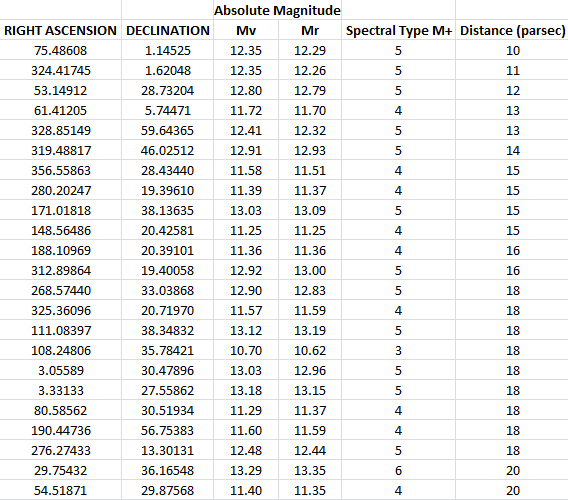Hunting for our nearest stellar neighbours in UCAC4
Why use UCAC4?
When the UCAC4 catalogue was released on 1st August 2012 I was immediately struck by the availability of Two Micron All Sky Survey (2MASS) and AAVSO Photometric all-sky survey DR6 (APASS) photometric results for many of the stars.
I remembered the 2011 paper “An All-Sky Catalog of Bright M Dwarfs” by Lepine and Giados (http://arxiv.org/abs/1108.2719) had suggested a variety of methods for identifying red dwarf stars and for distinguishing them from red giant stars. The same paper describes how the V-J magnitude can be used to calculate the absolute magnitude, or Mv, of a star.
The 2010 paper by Bochanski et al (http://arxiv.org/abs/1004.4002) "The Luminosity and Mass Functions of Low-Mass Stars in the Galactic Disk. II. The Field” includes the Color-Absolute Magnitude relationship for red dwarf stars based on the Sloan Digital Sky Survey (SDSS) (r-i) magnitude.
Finally the 2011 paper by West et al (http://arxiv.org/abs/1101.1082) “The Sloan Digital Sky Survey Data Release 7 Spectroscopic M Dwarf Catalog. I. Data” includes a table of the median colors for M0 to M9 red dwarf stars using SDSS magnitude data.
Data Mining for Nearby Red Dwarf Stars
Download all the stars where the proper motion is >40 mas/yr (see Lepine) and mean error <6 msas/yr and where reliable 2MASS magnitudes and APASS magnitude (see note) data exists.
(of flag = 0 and db flag =0) and (q_Jmag and q_Hmag and q_Kmag flags =5 or 6).
Apply the five color-color cuts to distinguish red dwarf stars from red giant stars (see Lepine).
Use the UCAC4 photometry to calculate the absolute magnitude (see both Lepine and Bochanski).
From the absolute magnitude calculate the distance.
Use the APASS results to estimate the spectral sub class of the red dwarf stars (see West).
Cautionary note - One complicating factor that is not made sufficiently clear in the UCAC4 material is that the B, V, g, r and i magnitudes from APASS suffer from saturation issue at magnitudes brighter than 10 ( see http://www.aavso.org/apass) for further information on this).If photometric analysis is required only APASS stars fainter than magnitude 10 should be processed.
Some preliminary results


This page was last updated on August 29th 2012.
Martin Nicholson - Ticklerton, Shropshire, United Kingdom